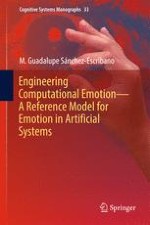2018 | OriginalPaper | Chapter
5. A Model of Computational Emotion
Author : M. Guadalupe Sánchez-Escribano
Published in: Engineering Computational Emotion - A Reference Model for Emotion in Artificial Systems
Publisher: Springer International Publishing
Activate our intelligent search to find suitable subject content or patents.
Select sections of text to find matching patents with Artificial Intelligence. powered by
Select sections of text to find additional relevant content using AI-assisted search. powered by
